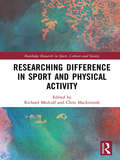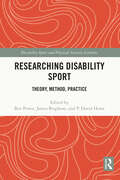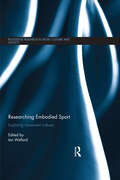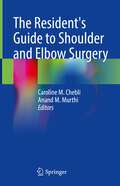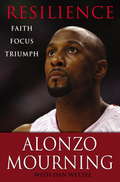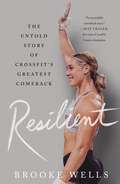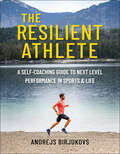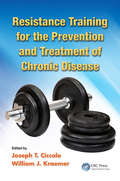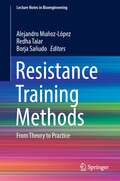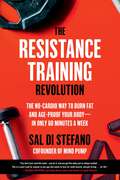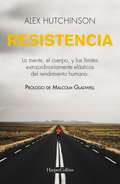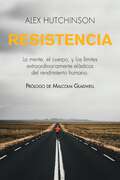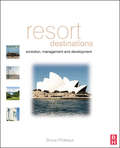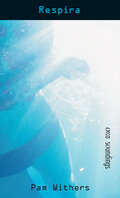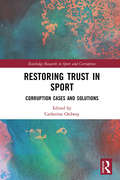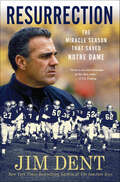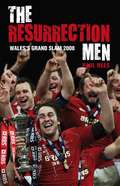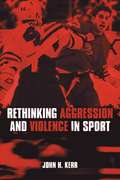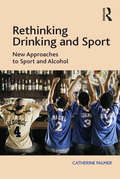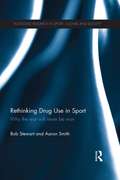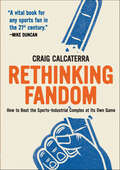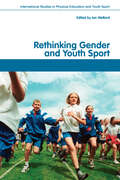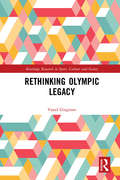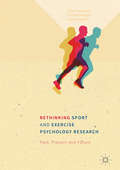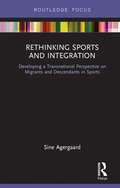- Table View
- List View
Researching Difference in Sport and Physical Activity (Routledge Research in Sport, Culture and Society)
by Richard Medcalf Chris MackintoshResearching Difference in Sport and Physical Activity goes beyond the content of introductory research methods texts to provide an insight into the methodological hurdles that are experienced when researching ‘difference’ in Sport and Physical Activity. Contributors reflect upon how the rhetoric of research methodology transfers into the reality of data collection across ‘difference’. Presenting case studies of real research projects, the book covers a range of topics, such as: disability in sport and physical activity vulnerable children in sport and physical activity visual research tools when working with children in a primary school setting physical activity, sedentary behaviour and obesity through childhood diverse ethnic groups in sport and physical activity settings. Each chapter contends with practical issues of power and representation within the research process, to recognise how a researcher–participant relationship that considers those who are ‘othered’ serves to change the dynamics and processes of research. This is an important resource for students of all sports related subjects and essential reading for anyone interested in the study of marginalised populations in sport and physical activity.
Researching Disability Sport: Theory, Method, Practice (Disability Sport and Physical Activity Cultures)
by Ben Powis James Brighton P. David HoweMarking a new direction for disability sport scholarship, this book explores cutting-edge issues and engages creatively with contemporary approaches to research in this important emerging discipline. Featuring contributions from leading and up-and-coming scholars around the world, the book’s wide-ranging chapters offer novel perspectives on the relationship between theory, method and empiricism in disability sport research and highlight how researchers can be both innovative and informed when entering the field. It also explores methodological considerations when conducting disability sport research, including social, cultural, and political reflections of the research process from disabled and non-disabled academics. This much-needed resource supports disability sport scholars in developing a conceptual grounding in the subject and establishes a space for intersectional accounts of sport and physical activity which challenge homogenous understandings of disability. This book is essential reading for any student or researcher working in disability sport, adapted physical activity, or adapted physical education, and a valuable reference for anybody with an interest in the sociology of sport, disability studies, cultural studies, the body, or research methodology.
Researching Embodied Sport: Exploring movement cultures (Routledge Research in Sport, Culture and Society)
by Ian WellardDespite a growing interest in the sociology of the body, there has to date been a lack of scholarly work addressing the embodied aspects which form a central part of our understanding and experience of sport and movement cultures. Researching Embodied Sport explores the political, social and cultural significance of embodied approaches to the study of sport, physical activities and dance. It explains how embodied approaches fit with existing theory in studies of sport and movement cultures and makes a compelling case for incorporating an embodied approach into the study of sporting practices and experience. The book adopts a multi-disciplinary lens, moving beyond the traditional dualism of body and mind, and incorporating the physical with the social and the psychological. It applies key theories that have shaped our thinking about the body and sport, and examines both the personal, subjective experience of sporting activities and those experiences involving engagement and contact with other people, in team sports for example. The book also explores the methodological implications of ‘doing’ embodied research, particularly in terms of qualitative approaches to sports research. Written by a team of leading international sports researchers, and packed with vivid examples from sporting contexts as diverse as surfing, fell running, korfball and disability sport, Researching Embodied Sport is fascinating reading for any advanced student or researcher working in the sociology of sport, physical cultural studies, physical education, body studies or health studies.
The Resident's Guide to Shoulder and Elbow Surgery
by Caroline M. Chebli Anand M. MurthiUtilizing a practical, high-yield presentation, this textbook is a comprehensive review of the most common shoulder and elbow diagnoses and management strategies. It allows easy access to pertinent information for residents and fellows while preparing for rounds, the clinic and the operating room and also aides residents studying for their yearly in-training exam (OITE). Each topic is organized in a consistent, bulleted format so that the information flows in a logic manner: history, physical examination, imaging (when and what to order), and the most appropriate treatment algorithm. The most common classification systems are emphasized and illustrated, and treatment algorithms are further organized into non-operative and operative and include surgical approaches as well as the risks and complications of surgical intervention. The shoulder and elbow are covered in their own exclusive sections, with each chapter discussing the unique diagnostic considerations for each anatomic structure and the types of injuries to expect. Topics in the shoulder section include osteoarthritis, rotator cuff arthropathy and tears, instability, stiffness, SLAP tears and biceps tendinitis, and fractures of the clavicle and scapula. Topics in the elbow section include biceps and triceps rupture, lateral and medical epicondylitis, instability and stiffness, and elbow fractures - distal humerus, Monteggia, the terrible triad and more. Case material, key points and takeaways, and question-and-answer elements are included to enhance the text's overall utility. There is currently no textbook on the shoulder and elbow tailored specifically for orthopedic residents, fellows and senior medical students. The Resident's Guide to Shoulder and Elbow Surgery therefore provides a much-needed resource for early-career clinicians and surgeons.
Resilience: Faith, Focus, Triumph
by Alonzo Mourning Dan WetzelMourning--NBA champion, Olympic gold medalist, kidney disease survivor, and community activist--details the faith, focus, and determination that have carried him through life.
Resilient: The Untold Story of CrossFit's Greatest Comeback
by Brooke WellsAn inspirational memoir about CrossFit star Brooke Wells' rise to fame and miraculous comeback.On the last night of the 2021 CrossFit Games, ten thousand fans watched in horror as Brooke Wells’ elbow dislocated under the weight of a 190-pound barbell. This is the extraordinary story of what happened next: How Wells pulled off a highly improbable comeback that transformed her mentally and physically into one of the fittest women in the world. In Resilient, Wells provides a refreshingly honest, authentic account of how she overcame fear, self-doubt, and a slew of unexpected obstacles to return to the CrossFit Games less than a year after undergoing total elbow reconstruction. A story of strength, passion, courage, and grit, Resilient is a celebration of one athlete's extraordinary spirit and her inspiring ability to never say die.
The Resilient Athlete: A Self-Coaching Guide to Next Level Performance in Sports & Life
by Andrejs BirjukovsThe Resilient Athlete presents a step-by-step self-coaching framework designed to build foundational fitness and develop athletic resilience while optimizing your training for sports, athletics and adventure.The Resilience Athlete presents a series of self-coaching sessions, much like ones people would have with a performance coach. These are not geared towards one particular sport, but rather focus on creating an ultimate athletic experience, one where physical and emotional states are in balance with purpose.Inside the book, readers will discover:Actionable advice to incorporate into one's daily training Strategies to cultivate the mindset to take on challenges and grow in confidence Systems to adopt healthy lifestyle habits to have more energy and feel less stressedThe Resilient Athlete also features training tactics, schedules, and plans to help readers optimize fitness while becoming the very best they can be as an athlete.Online support via social media, community forums, and website featuring additional content such as exclusive exercise videos, nutritional tips, live updates from authors, and more is available.Resilient athletes are made, not born and The Resilient Athlete makes it easy for anyone to learn how to become one. Training for a challenge or goal can be daunting, and the journey fraught with the potential for injury or other setbacks.
Resistance Training for the Prevention and Treatment of Chronic Disease
by Joseph T. Ciccolo William J. KraemerCurrent evidence supports the use of resistance training as an independent method to prevent, treat, and potentially reverse the impact of numerous chronic diseases. With physical inactivity one of the top risk factors for global mortality, a variety of worldwide initiatives have been launched, and resistance training is promoted by numerous organisations. An evidence-based guide, this book presents an in-depth analysis of the independent and positive effects of resistance training on the prevention, management, and treatment of many chronic conditions. Written by some of the world's leading exercise physiologists and resistance training experts, the chapters provide detailed descriptions of the benefits of resistance training for specific clinical populations, including guidelines on how to construct a tailored resistance training prescription. Chapters cover resistance training to treat cardiovascular disease, metabolic diseases, cancer, orthopedic diseases, neuromuscular disorders, and more.
Resistance Training Methods: From Theory to Practice (Lecture Notes in Bioengineering)
by Alejandro Muñoz-López Redha Taiar Borja SañudoThis book reviews the main principles of resistance training, from basics to modern insights. It includes practical ways to develop most of the strength training methods, including monitoring and testing procedures. It merges practical tips with knowledge about the scientific background concerning program and periodization. It describes procedures for special populations, such as elderly or women.Gathering contributions by authoritative researchers and professors in the fields of sport science and biomechanics, this book provides an integrated view of strength training programming, and describes the most important biological factors associated with this type of training. The evidence-based and detailed description of each single mechanism to be trained to enhance performance is covered in depth. Thanks to its strong academic background, an being self-contained, this book offers a valuable reference guide for advanced undergraduate and graduate students in sports science, as well as an inspiring guide for sport and health researchers and professional trainers alike.
The Resistance Training Revolution: The No-Cardio Way to Burn Fat and Age-Proof Your Body—in Only 60 Minutes a Week
by Sal Di StefanoBurn fat, build lean, sexy muscles, lose inches, and feel healthier, more energetic, and youthful than you ever have in your life…with a revolutionary new approach to resistance training. Tired of spending hours on the treadmill? Dealing with the joint paint of high impact exercise? And seeing very few results in terms of fat-burning and weight loss? If so, it&’s time to join the revolution. Brought to you by Sal Di Stefano, the founder of the mega popular Mind Pump podcast, The Resistance Training Revolution reveals how resistance training is the best form of exercise to burn fat, boost metabolism, and achieve health benefits you cannot obtain from other forms of exercise.Di Stefano breaks down fitness misconceptions, shares his decades of industry knowledge, and brings you a comprehensive, accessible guidebook that will give you the body you&’ve always wanted—in as little as 60 minutes a week. This book features: Over 60 fat-burning, metabolism-boosting workouts you can do at home to sculpt your body and maximize your health and longevityRaw fitness truths that will show you what works and what doesn&’t. You&’ll be shocked at how easy it is to build lean muscle and lose fat once you understand these truths, and once you train your body the right wayThe newly discovered health benefits of resistance training in terms of heart health, bone strength, joint protection, and especially antiagingThe exact formula for nutrition that makes losing fat, while sculpting your body a breeze and for the long term.Dozens of self-assessments to track your progress, and much moreThe Resistance Training Revolution also reveals how to optimize your workout time following Mind Pump&’s Muscular Adaptation Programming System (MAPS)—a system that ensures that you keep making progress without the frustrating plateaus. Isn&’t it time you joined the revolution?
Resistencia: La mente, el cuerpo y los límites extraordianariamente elásticos del rendimiento humano
by Alex HutchinsonLa capacidad para resistir es el rasgo clave que subyace al gran rendimiento en prácticamente todos los campos, desde un sprint de 100 metros hasta un ultra maratón de 100 millas, desde la cumbre del Everest hasta la realización de exámenes finales o la finalización de cualquier proyecto difícil. Pero, ¿y si todos podemos ir más lejos, presionar más y lograr más de lo que pensamos que somos capaces de hacer?Combinando la ciencia de vanguardia y la apasionante narración en el espíritu de Malcolm Gladwell, quien contribuye con el premiado periodista del libro Alex Hutchinson, revela que una ola de investigaciones que alteran el paradigma durante la última década sugiere que las barreras aparentemente físicas que enfrentas se establecen como tanto por tu cerebro como por tu cuerpo. Esto significa que la mente es la nueva frontera de la resistencia y que los horizontes del rendimiento son mucho más elásticos de lo que alguna vez pensamos.Pero, por supuesto, no todo está en tu mente. Para cada uno de los límites físicos que Hutchinson explora -dolor, músculos, oxígeno, calor, sed, combustible-, desentraña cuidadosamente la delicada interacción de la mente y el cuerpo contando fascinantes historias de hombres y mujeres que han superado sus propios límites de formas extraordinarias.
Resistencia: Mente, cuerpo y los límites curiosamente elásticos del rendimiento humano
by Thomas NelsonLa capacidad para resistir es el rasgo clave que subyace al gran rendimiento en prácticamente todos los campos, desde un sprint de 100 metros hasta un ultra maratón de 100 millas, desde la cumbre del Everest hasta la realización de exámenes finales o la finalización de cualquier proyecto difícil. Pero, ¿y si todos podemos ir más lejos, presionar más y lograr más de lo que pensamos que somos capaces de hacer?Combinando la ciencia de vanguardia y la apasionante narración en el espíritu de Malcolm Gladwell, quien contribuye con el premiado periodista del libro Alex Hutchinson, revela que una ola de investigaciones que alteran el paradigma durante la última década sugiere que las barreras aparentemente físicas que enfrentas se establecen como tanto por tu cerebro como por tu cuerpo. Esto significa que la mente es la nueva frontera de la resistencia y que los horizontes del rendimiento son mucho más elásticos de lo que alguna vez pensamos.Pero, por supuesto, no todo está en tu mente. Para cada uno de los límites físicos que Hutchinson explora -dolor, músculos, oxígeno, calor, sed, combustible-, desentraña cuidadosamente la delicada interacción de la mente y el cuerpo contando fascinantes historias de hombres y mujeres que han superado sus propios límites de formas extraordinarias.EndureThe capacity to endure is the key trait that underlies great performance in virtually every field—from a 100-meter sprint to a 100-mile ultramarathon, from summiting Everest to acing final exams or completing any difficult project. But what if we all can go farther, push harder, and achieve more than we think we&’re capable of?Blending cutting-edge science and gripping storytelling in the spirit of Malcolm Gladwell—who contributes the book&’s foreword—award-winning journalist Alex Hutchinson reveals that a wave of paradigm-altering research over the past decade suggests the seemingly physical barriers you encounter as set as much by your brain as by your body. This means the mind is the new frontier of endurance—and that the horizons of performance are much more elastic than we once thought.But, of course, it&’s not &“all in your head.&” For each of the physical limits that Hutchinson explores—pain, muscle, oxygen, heat, thirst, fuel—he carefully disentangles the delicate interplay of mind and body by telling the riveting stories of men and women who&’ve pushed their own limits in extraordinary ways.
Resort Destinations
by Bruce PrideauxDestination management and resort development and planning are strong core areas in the final year of most undergraduate degrees and a popular area of study at postgraduate level. Using original case studies based on his own research, Resort Destinations uses examples from Australia's Gold Coast, Britain's Brighton, USA's Las Vegas, as well as Hong Kong, New Zealand and the Caribbean.
Respira: (Breathless) (Spanish Soundings)
by Pam WithersBeverly está en Hawaii ayudando a su tío en su tienda de submarinismo, aprendiendo a bucear y tratando de bajar de peso y conseguir novio. Cuando Garth, un excelente buzo, se interesa por ella, Beverly está feliz, hasta que resulta que a Garth no le interesa más que una cosa. Cada vez más débil por la drástica dieta que se impuso ella misma, Beverly se encuentra en graves problemas cuando tiene que defenderse de Garth bajo el agua. Beverly is in Hawaii, helping her uncle at his dive shop, learning how to dive and trying to lose weight and get a boyfriend. When Garth, an accomplished diver, shows an interest in her, Beverly is ecstatic, until it turns out Garth is only interested in one thing. Struggling with failing strength from her self-imposed starvation diet, Beverly finds herself in deep trouble when she has to fight Garth off underwater.
Restoring Trust in Sport: Corruption Cases and Solutions (Routledge Research in Sport and Corruption)
by Catherine OrdwayIn this solutions-focused collection of sport corruption case studies, leading researchers consider how to re-establish trust both within sports organisations and in the wider sporting public. Inspired by the idea of ‘moral repair’, the book examines significant corruption cases and the measures taken to reduce further harm or risk of recurrence. The book has an international scope, including case study material from Europe, Asia, Africa, Australia and New Zealand, and covers important contemporary issues including whistleblowing, bribery, match-fixing, gambling, bidding for major events, and good governance. It examines the loss of trust at both national and international levels. Drawing on cutting-edge research, the book includes both on-field and off-field examples, from Olympic, non-Olympic, professional and amateur sports, as well as diverse academic and practitioner perspectives. Offering an important contribution to current debates and a source of reflection on best professional practice, Restoring Trust in Sport helps us to better understand why corruption happens in sport and how it can and should be addressed. This is invaluable reading for all advanced students, researchers, managers and policy makers with an interest in integrity in sport, sport ethics, sport management, sport governance, sports law, and a useful reference for anybody working in criminology, business and management, law, sociology or political science.
Resurrection: The Miracle Season That Saved Notre Dame
by Jim DentJim Dent, author of the New York Times bestselling The Junction Boys returns with the remarkable and inspiring story of one of the biggest comebacks in college football history.In the 1960's, Notre Dame's football program was in shambles. Little did anyone know, help was on its way in the form of Ara Parseghian, a controversial choice for head coach—the first one outside of the Notre Dame "family." It was now his responsibility to rebuild the once-proud program and teach the Fighting Irish how to win again. But it was no small task.The men of Notre Dame football were a bunch of unlikelies and oddballs, but Parseghian transformed them into a team: a senior quarterback who would win the Heisman Trophy; a five-foot-eight walk-on who would make first team All-American; an exceptionally rare black player, who would overcome much more than his quiet demeanor to rise to All-American, All-Pro, Hall of Famer, and to the Minnesota Supreme Court. Parseghian would change everything, from the uniforms and pads to the offensive strategy. It would be a huge gamble against great obstacles. But Ara Parseghian had that look in his eye….New York Times bestselling author Jim Dent chronicles one of the greatest comeback seasons in the history of college football. Once again confirming his position as one of the top sports writers in the country, Dent brings the legends of Notre Dame football to life in an unforgettable story of second chances, determination, and unwavering spirit.
The Resurrection Men: Wales' Grand Slam 2008
by Paul ReesWales were written off as no-hopers at the start of the 2008 Six Nations. They had failed to reach the World Cup quarter-finals the previous October and had reacted by appointing their 13th coach in 19 years, New Zealander Warren Gatland.On the opening weekend, success appeared unlikely when they trailed World Cup finalists England at Twickenham by ten points at half-time. Their second-half comeback, to earn their first victory at the ground for 20 years, set them on their way, and there was no looking back. In a blistering campaign, they set a new Six Nations record by conceding just two tries in their five matches.The Resurrection Men looks back over the glorious 2008 tournament but also examines the reasons why the foundations laid by Gatland look more secure than those established by Mike Ruddock before his controversial departure from the role less than a year after the side's last Grand Slam triumph in 2005. Wales imploded after Ruddock left, winning only one match in each of the 2006 and 2007 campaigns. His successor Gareth Jenkins asked to be judged on the team's performance in the World Cup. And he was, sacked hours after the defeat to Fiji which meant that, for the third time in five tournaments, Wales failed to make the knock-out stage. Little more than a week later, Welsh Rugby Union officials boarded a plane to New Zealand to meet Gatland and other candidates for head coach. Just two minutes into the meeting, they were ready to offer him the job. He promised them that if Wales won at Twickenham on the opening weekend, the slam would be on. They did and it was.
Rethinking Aggression and Violence in Sport
by John H. KerrRethinking Aggression and Violence in Sport explores the psychological aspects of these two intrinsic elements of competitive sport. This book critically examines the important issues associated with aggression and violence in sport, including: * a review of current theory in the psychology of aggression * exploration of how players become acclimatised to physical violence* discussion of the psychological benefits of sanctioned and unsanctioned sport violence* examination of the moral and ethical dimensions of the debate* the psychological basis of spectator aggression* case studies from a wide variety of sports. This text is a must read for researchers and students within sport studies, psychology and sociology with an interest in human violence and aggressive behaviour.
Rethinking Drinking and Sport: New Approaches to Sport and Alcohol
by Catherine PalmerRethinking Drinking and Sport examines the complex nature of sport-related drinking. With close attention to the contradictory nature of sport-related drinking, this book considers both 'the problem' of drinking in sport, as well as some of the issues for treatment and recovery that sports-related drinking presents. Bringing together a range of methodological and theoretical debates that address the relationships between alcohol and sport, Rethinking Drinking and Sport draws on rich new interview material with fans and both drinking and non-drinking sportsmen and women, as well as documentary and media sources. Based on research across a variety of sports in the UK and Australia, Rethinking Drinking and Sport explores not only the relationship between alcohol, fans, participants and industry, but also questions of gender and identity to provide fresh insights into the complex relationships between drinking and sport. Examining possible directions for health and public policy in relation to sport-related drinking, this book will appeal to social scientists and policy makers with interests in consumption, leisure, sport, drinking, and health.
Rethinking Drug Use in Sport: Why the war will never be won (Routledge Research in Sport, Culture and Society)
by Bob Stewart Aaron SmithDrug free sport is an unattainable aspiration. In this critical, paradigm-shifting reappraisal of contemporary drug policy in sport, Bob Stewart and Aaron Smith argue that drug use in sport is an inexorable consequence of the nature, structure and culture of sport itself. By de-mythologising and de-moralising the assumptions that prop up current drug management controls, and re-emphasising the importance of the long-term well being and civil rights of the athlete, they offer a powerful argument for creating a legitimate space for drug use in sport. The book offers a broad ranging overview of the social and commercial pressures impelling drug use, and maps the full historical and social extent of the problem. With policy analysis at the centre of the discussion, the book explores the complete range of social, management, policy, scientific, technological and health issues around drugs in sport, highlighting the irresolvable tension between the zero-tolerance model as advanced by WADA and the harm-reduction approach adopted by drug education and treatment agencies. While there are no simple solutions, as long as drugs use is endemic in wider society the authors argue that a more nuanced and progressive approach is required in order to safeguard and protect the health, social liberty and best interests of athletes and sports people, as well as the value of sport itself.
Rethinking Fandom: How to Beat the Sports-Industrial Complex at Its Own Game
by Craig Calcaterra&“Modern fandom is rubbish, and Calcaterra explains why, but in so doing, also shows us the way out of our desensitized, corporate, laundry-hugging ways.&” —Keith Law, The Athletic Sports fandom isn&’t what it used to be. Owners and executives increasingly count on the blind loyalty of their fans and too often act against the team&’s best interest. Sports fans are left deliberating not only mismanagement, but also political, health, and ethical issues. In Rethinking Fandom, sportswriter (and lifelong sports fan) Craig Calcaterra outlines endemic problems with what he calls the Sports-Industrial Complex, such as intentionally tanking a season to get a high draft pick, scamming local governments to build cushy new stadiums, actively subverting the players, bad stadium deals, racism, concussions, and more. But he doesn&’t give up on professional sports. In the second half of the book, he proposes strategies to reclaim joy in fandom: rooting for players instead of teams, being a fair-weather fan, becoming an activist, and other clever solutions. With his characteristic wit and piercing commentary, Calcaterra argues that fans have more power than they realize to change how their teams behave. &“If you&’re like me and love sports but have become increasingly dismayed by the &‘sports-industrial complex,&’ Calcaterra&’s book will prove a balm that allows you to hold onto that fandom without turning a blind eye to the myriad problems and sources of exploitation on the field.&” —John Warner, The Chicago Tribune &“Rather than simply criticizing, Calcaterra provides positive solutions to help us form a healthier and more thoughtful relationship with the sports we love. A vital book for any sports fan in the 21st century.&” —Mike Duncan, New York Times–bestselling author
Rethinking Gender and Youth Sport (Routledge Studies in Physical Education and Youth Sport)
by Ian WellardMuch writing on gender and sport is focused upon the negative impact of girls’ exclusion from the arena, suggesting by inference that current practice in sport and physical education offers an uncomplicatedly positive sport experience for boys, and that gender, in and of itself, offers a simple starting point for research into young people’s experience of sport. Rethinking Gender and Youth Sport articulates certain themes which, it is suggested, might contribute to broadening and furthering discussion in the area of gender, youth sport and physical activity. This collection considers a number of themes relating to gender in sport, including: the body competence, ability and school physical education cultural change and diversity gendered spaces human rights and well-being. Authoritative writers have contributed thought provoking chapters which will prompt the reader to re-think the ways in which gender is understood within the context of youth sport.
Rethinking Olympic Legacy (Routledge Research in Sport, Culture and Society)
by Vassil GirginovHow do Olympic legacies come about? This book offers an alternative approach to the study of Olympic and mega-sport event legacy, challenging how legacy is conceptualised and practised. It shifts the focus from legacy as a retrospective concept concerned with what has been left behind after the Games, to a prospective one interested in actions and interactions stimulated by the Games. The book argues that creating Olympic legacy is a continuing four-stage process involving ‘investing’ (the accumulated common Olympic cultural capital), ‘interpelling’ (forming a trusteeship relationship where one party undertakes to change the capacity of another), ‘developing’ (ensuring participation in interactions and resource development) and ‘codifying’ (documenting, sharing and remembering legacies so they become cultural capital). It presents a developmental approach to the Olympics which involves vision, trustees and trusteeship and is concerned with capacity building at individual, organisational and societal levels. Thinking of Olympic legacy as capacity building allows seeing the goal of legacy as an embodiment of the aspirations of the Olympic Movement and the Games to introduce radical change in society by transforming its structure. Rethinking Olympic Legacy is essential reading for all students and scholars within an interest in the Olympics, as well as for administrators, policymakers and planners involved with mega-sport events.
Rethinking Sport and Exercise Psychology Research
by Peter Hassmén Richard Keegan David PiggottThis book provides a comprehensive historical account of the evolution of Sport and Exercise Psychology research, charting the progression of the field from the early days when well-controlled experimental research was the standard, to the subsequent paradigm war between positivism, post-positivism and constructivism. The book challenges current thinking and makes a plea for a move towards a future in which the accumulation of knowledge is at the core of Sport and Exercise research, rather than simply methods and measurements. The result is a critique not only of exercise and sport psychology, but of psychological research methods more broadly. It will be of great interest to researchers and students working in Sport Science, Research Methods, and Psychology.
Rethinking Sports and Integration: Developing a Transnational Perspective on Migrants and Descendants in Sports (Routledge Focus on Sport, Culture and Society)
by Sine AgergaardRethinking Sports and Integration offers a critical cultural analysis of the idea that sport can promote the integration of migrants and their descendants. It examines the origins of this idea and the concept of integration, and analyzes the problems in focus, the methods applied and the results of sports-related integration programmes. The text also redefines sports-related integration with perspectives from migration studies that highlight the super-diversity within migrant groups, and explore the various ways in which transnational connections influence participation in sport within migrant communities. This book is important reading for students and researchers working in sport development, sport policy or migration studies, as well as a valuable resource for sports governing bodies, policymakers and project workers.
